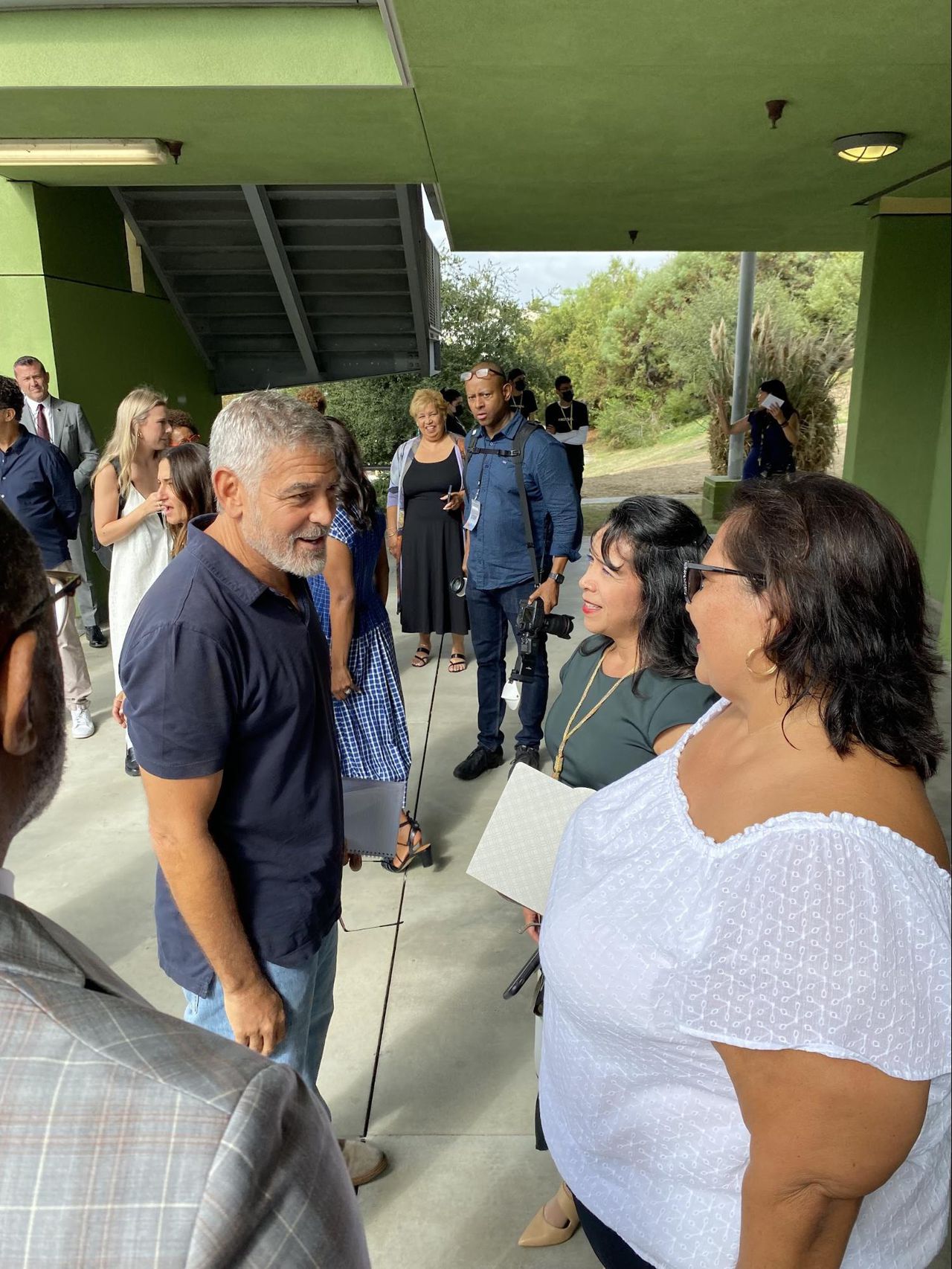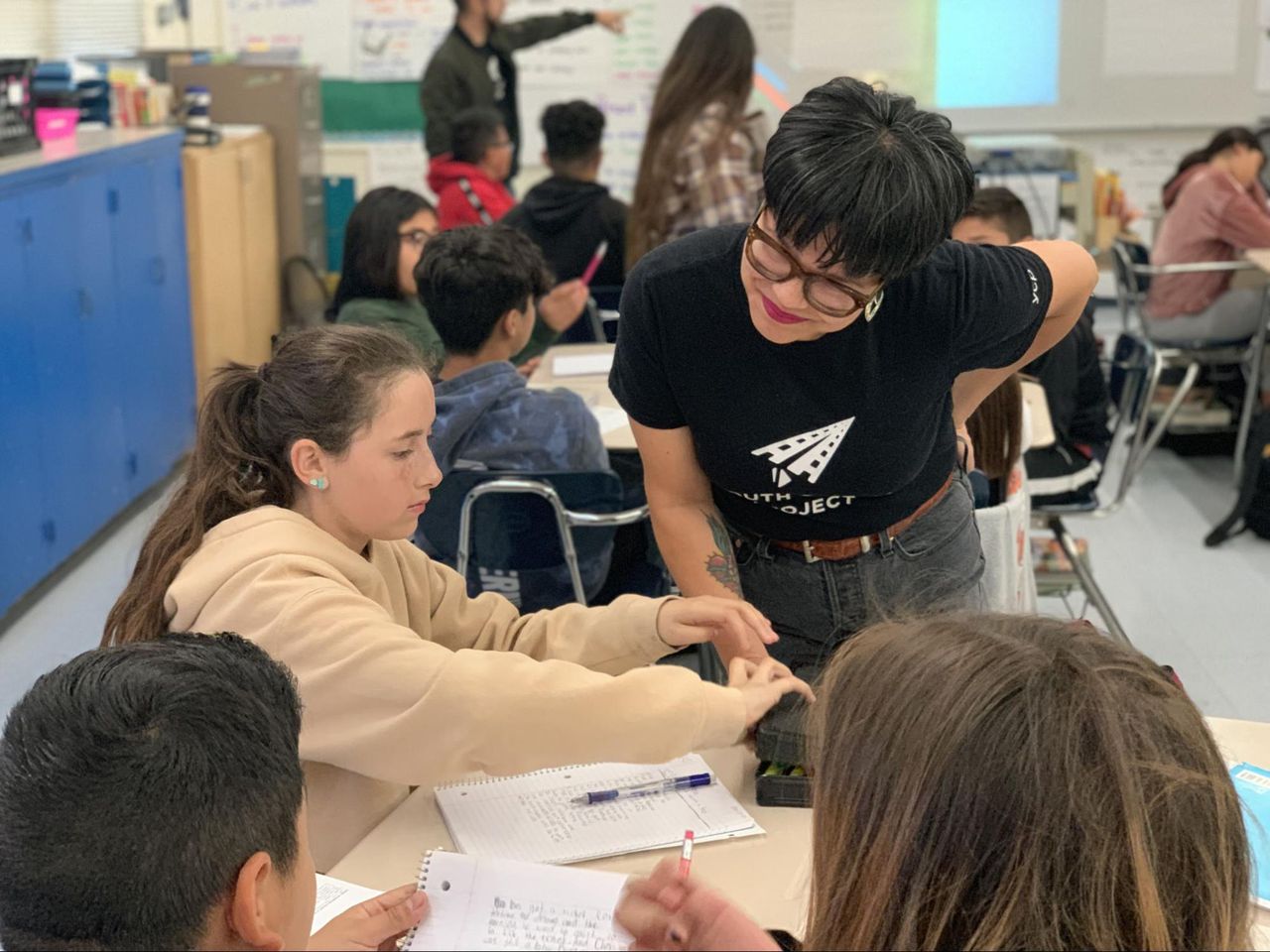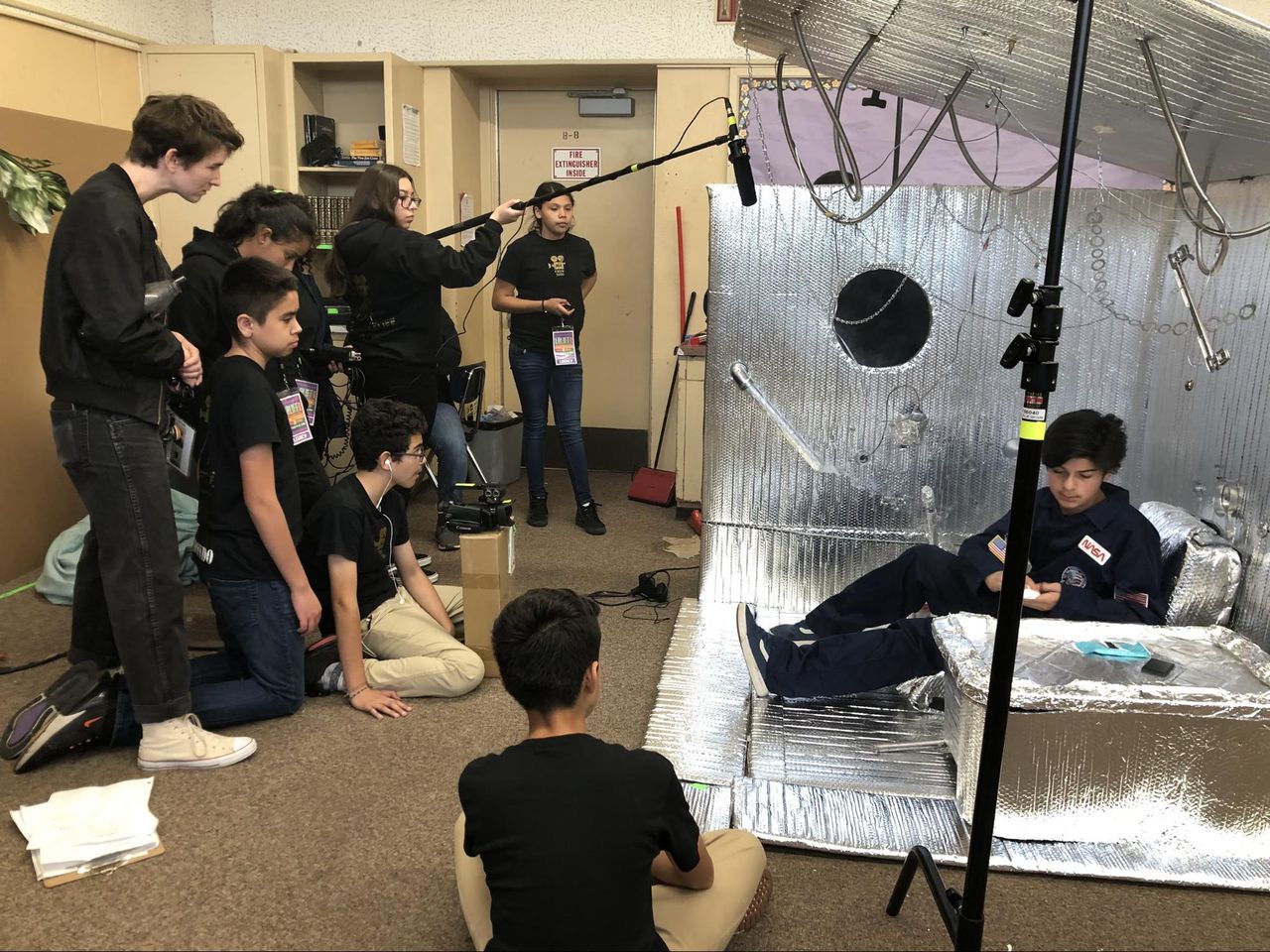Hollywood A-listers change the face of American entertainment, 1 classroom at a time
Editor’s note: This is the final installment in a three-part series on how Latinos are navigating the entertainment industry. It first appeared on palabra, the digital news site by the National Association of Hispanic Journalists.
By Saida Pagán
It was a sunny Friday morning in Bell Gardens, California, a suburb a few miles southeast of downtown Los Angeles where the majority of the residents are Latino. Over at Suva Intermediate School, a class of eighth graders were busy at work. Their assignment was simple yet complex: make their Hollywood dream come true.
Twice a week a spacious classroom at the far end of the campus turns into a movie set. As part of actor Edward James Olmos’ Youth Cinema Project, entertainment professionals known as mentors teach the students just about every aspect of film production imaginable: from screenwriting to cinematography to editing.
“I have never done anything that has given me more satisfaction in the sense of understanding what we can do to help ourselves,” Olmos said.
The internationally acclaimed activist and star of iconic films such as “Stand and Deliver,” “Selena,” and “American Me,” began the youth-oriented education program in the late 1990s, but its most recent iteration has existed since 2013.
A group of Youth Cinema Project students film a scene. Photo courtesy: Youth Cinema Project.
On this Friday morning, a group of students walked around the classroom with the self-confidence of seasoned professionals – yet laughing and joking like typical teenagers. Their spirits were especially high on this day as they got ready to complete the final scenes of “Class President,” a short film that they hoped would earn rave reviews.
Over on one side of the room, a group of boys expertly set up camera equipment and lights. Behind them, four girls rehearsed their big scene like the major stars they might someday become.
One of them was Valerie Ramirez. She was serving as assistant director on the movie, and had also written and produced it.
“It’s a really good program that changed me in a positive way. It made me less shy. I’m inspired – I feel fortunate,” Ramirez explained.
Olmos has specifically chosen to bring his ever-expanding Youth Cinema Project to some of the most underserved communities in California. There are now approximately 1,450 students at 37 schools benefiting from the program.
“Point the camera in the other direction,” called out writer/director Jianna Maarten, the mentor-teacher standing in the middle of the room coordinating the production.
Over in the corner, still another group of students sat at computers, focused on editing footage while receiving instruction from Mia Mollicone, an actor/producer and Youth Cinema Project mentor.
“I believe this program absolutely makes a difference. Filmmaking in the Latino community has not been taught. We’re teaching this program to kids who haven’t had this opportunity in the past,” Mollicone said. “They are seeing that there are no barriers. The Youth Cinema Project is empowering the students.”
And the YCP experience extends beyond the classroom. It includes summer workshops and assistance in obtaining internships with industry partners. Students who have finished the program but want additional opportunities have the option of participating in more advanced coaching sessions with media professionals and attending in-person events. At the end of the school year, the movies that the students produce are often shown at world-class venues including the Los Angeles Latino International Film Festival, established by Olmos more than 20 years ago.
In June, the Suva Intermediate School film, “Class President,” was among 100 YCP projects featured at the festival known as LALIFF, and is currently showcased on YouTube.
But teaching kids about movie production is only one part of the program’s mission.
“We are using film as a medium, but we are really trying to teach communication, teamwork, self-advocacy, self-confidence, and using their voices,” said YCP program director Erika Sabel Flores. “(These are) all the things that they will be able to use whether they become a filmmaker or not,” she explained.
This quest to level the playing field for diverse communities seeking employment in the media has taken on a greater sense of urgency in recent years with calls for greater access and more authentic storytelling.
While Latinos comprise nearly 19% of the U.S. population, the Directors Guild of America 2020-21 Episodic Television Inclusion Report, for example, found that only 9% of all TV show directors self-identified as Latino. Similar research has also shown disproportionately low percentages of Latinos in other professional entertainment job categories as well.
Related stories in the series:
“If Latinos and Latinas are (approaching) 50% of the California population, why are we only about 5% of the major roles in motion pictures?” asked Rafael Agustin, CEO of the Latino Film Institute, when discussing hiring practices in Hollywood. “These jobs need to start looking like the taxpayers of this state,” he said in an interview last year.
Growing opportunities
Back at Suva Intermediate School, student Alexander Figueroa took a break from his editing assignment to reflect on his semester-long journey into filmmaking. He said he had found the program to be transformative. “At first I didn’t think that I would like filmmaking, but after (the class started), I really got interested.”
Now Figueroa and his family are already researching colleges where he can study film production – and in the fall, both he and Ramirez began attending a nearby high school where the Youth Cinema Project also operates.
“I’m hoping to keep going – become a director and make my own films,” Figueroa said.
And the good news is that there is more opportunity coming on the education front. Other Hollywood celebrities have also begun sponsoring their own filmmaking academies at public schools in the L.A. area. As a result, hundreds of additional students from low to moderate -income families, first in Los Angeles and eventually in other U.S. cities, may be able to take advantage of film programs similar to the one at Suva Intermediate.

Actor George Clooney greets staff members at the new Roybal School of Film and Television Production Magnet in Los Angeles in September. Photo courtesy: The Los Angeles Unified School District
Probably the latest high-profile effort was the September opening of The Roybal School of Film and Television Production Magnet in the Los Angeles Unified School District.
The new film magnet was founded by Academy Award-winning actor and activist George Clooney, and includes advisory board members such as actors Don Cheadle, Mindy Kaling, Grant Heslov, Eva Longoria, and Creative Artists Agency co-chairman Bryan Lourd.
The inaugural class of 150 freshmen and sophomores will receive guidance from industry professionals, storytellers and other experts as they learn to write, direct, produce, and edit film projects. This training will be embedded in core academic classes and will enable students to graduate with the advanced knowledge and skills that may eventually lead to behind-the-scenes careers in the film industry.
“There are literally 65,000 jobs that they (the students) don’t know about,” said Clooney. “These are jobs (that) unless you know about them you can’t chase them,” he said, adding, “We aim to change that and make sure that our industry is part of that,” said Clooney, known not only for his acting but also for his activism and humanitarian work.
Speaking to a cheering crowd of students, educators, and guests in a packed auditorium at the magnet school’s grand opening, Clooney went on to announce that major movie studios such as Amazon, Disney, and Warner Bros Discovery, have committed more than $4-million to help fund the program. The studios and trade unions have also pledged to support students during their high school years and after graduation. “There are going to be internships and apprenticeships and actual jobs,” Clooney said. “(This) will lead to better and better jobs, so that we can change the complexity of this industry.”
Clooney also stated that if the Roybal School of Film and Television Production Magnet program is successful in L.A., there is a possibility that the educational model may be adopted in cities such as New York, Chicago, and Atlanta.
As the grand opening ceremonies came to a close, high school freshmen Bryan Zambrano and Michael Ramos lingered in the school auditorium for just a brief moment, reflecting on what they had just heard that morning.
“The speeches that were given today were very inspiring. My career plans are to graduate from this high school, probably go to a college, take editing classes, and try to get into the film industry,” Zambrano explained.
“This lets me know I have more options for the future, such as film editing, script writing, and more,” Ramos said. “It inspires me.”
After years of working to open doors for diverse communities in Hollywood, Olmos and others who have long championed early education, career training, and mentoring as a means of driving transformational change are now finally seeing the fruits of their labor.
Could it be that someday soon, the face of Hollywood will finally look like the America of the 21st century?
“All we need is the courage to take the steps to be the best that we can be, and we’re getting there,” Olmos said. “The future is in our own hands.”

A Youth Cinema Project mentor helps guide students on the basics of filmmaking. Photo courtesy: Youth Cinema Project
—
Saida Pagán is a Los Angeles-based journalist and the winner of three recent Los Angeles Press Club Awards for entertainment reporting and a first-place award in the National Arts and Entertainment Journalism Awards competition. In 2021, she received two first-place awards from the National Association of Telecommunications Officers and Advisors for her documentary work. Pagán was born and raised in New York City, and is of Puerto Rican heritage. She has worked as a newscaster for television stations across the United States, and has appeared in nearly 100 primetime television programs, major motion pictures and other on-camera projects. Pagán holds a master’s degree with distinction in Strategic Communication, and also conducts webinars on the media and communication.
